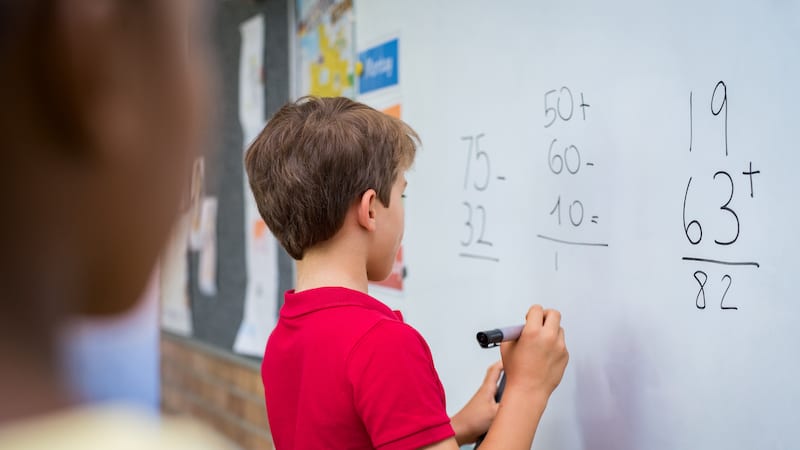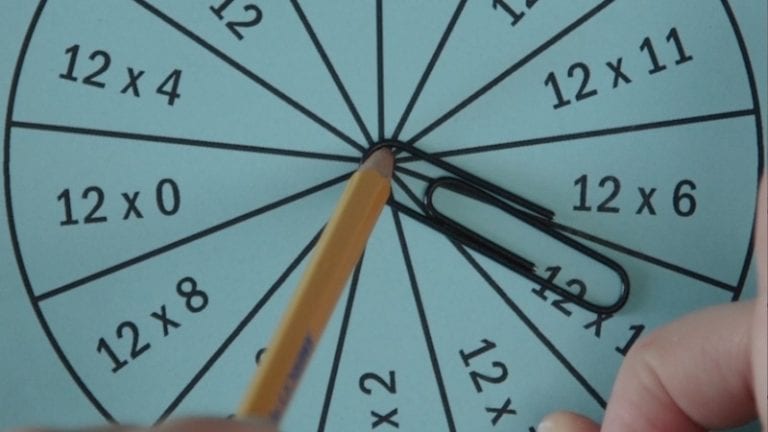Third grader Liam dreads math class. He always has. In preschool, he had trouble counting to 10 and sorting blocks by shape and color. In first grade, memorizing addition and subtraction facts seemed impossible, no matter how many times he and his dad went through the flashcards each night. The kids in his class are now working on multiplication and division, while he’s still struggling to understand if 35 is greater than or less than 24.
His dad says he’s not trying hard enough, and his teacher just assigns more homework and recommends more practice. “Why can’t I understand simple math?“ Liam wonders. The answer is a long word he’s never heard, and one his parents and teachers probably haven’t either: dyscalculia. Take a look at our video here.
[embedyt] https://www.youtube.com/watch?v=YUlJyIMz134[/embedyt]
What is dyscalculia?
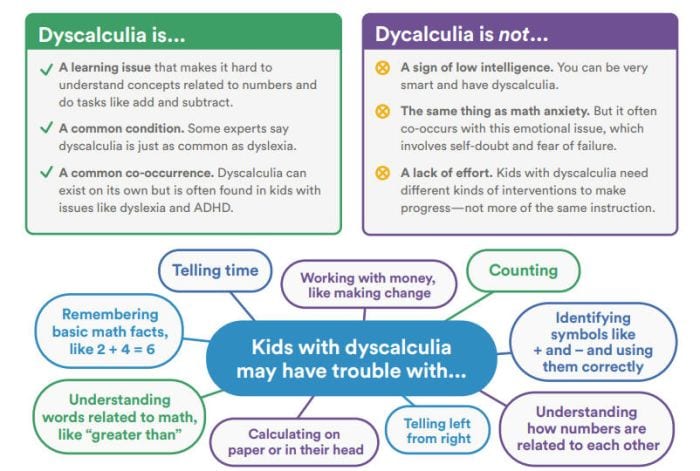
Excerpt from the Dyscalculia Fact Sheet, via Understood.org. Get the full printable fact sheet.
Dyscalculia (pronounce dis-cal-KYOOL-ee-ah) is a math learning disorder (sometimes called math dyslexia, though that’s a misleading name). Unlike dyslexia, it’s not nearly as recognized or understood, and people who have it may struggle for years or their entire lives without getting the assistance they need. In much the same way people with dyslexia simply don’t see letters and words in the same way as folks without, those with dyscalculia have trouble with “number sense.”
For them, the concept of “7 = seven” is confusing. They have difficulties putting numbers in order or understanding the idea of “greater than or less than” (made even worse when shorthand symbols like “>” or “<” come into play). Memorization isn’t just a matter of time and practice for them—it may be nearly impossible.
[contextly_auto_sidebar]
No one is sure how many people have dyscalculia, though estimates run at 3–6 percent of the population. It often seems to coincide with other learning disorders (researchers estimate that 40–60 percent of kids with math disabilities also have reading disabilities) and ADHD. Whatever the case, teachers are often the first to notice and help identify this and other learning disorders, so it’s important for them to know what to look for in and out of the classroom.
Learn how to recognize dyscalculia signs.
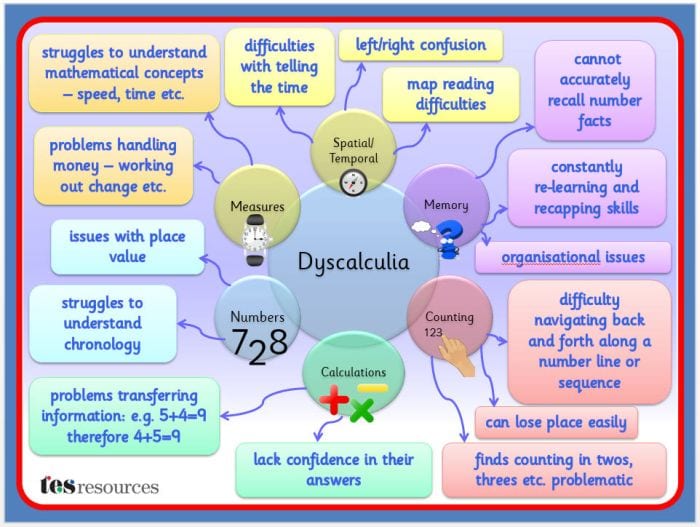
Image credit: TES Resources
Teachers know that every classroom contains kids with a variety of skill levels who learn at different rates. Given that, how can you know whether your student is dealing with a learning disorder rather than just not applying themselves? Here are some typical dyscalculia signs to look for at various ages.
Pre-K
Dyscalculic kids at this age have trouble counting to ten, even after much practice. They don’t seem to understand what numbers represent—you may ask them for three crayons, and they hand you a whole pile. They may also fail to understand patterns and sorting. Learn more about the ways Pre-K students are affected.
Elementary School
This is the age where math learning disorders are most likely to make themselves known. These are the kids still counting on their fingers when everyone else has memorized their basic addition and subtraction facts. They may not make the connection that “+” means “plus,” or that it’s used in addition. Mental math is especially difficult for them, as are word problems. They’ll actively avoid games that require any type of math or counting, like Monopoly or Chutes & Ladders. Learn more about the ways elementary students are affected.
Middle and High School
Beyond basic math challenges, kids with dyscalculia find it hard to understand concepts like the commutative property (3 + 5 = 5 + 3) or substitution (x = 11). They’ll continue to have trouble memorizing facts involving numbers, like formulas, which can affect them in other subjects like chemistry. Learn more about ways that middle school and high school students are affected.
Other Dyscalculia Challenges
Even outside the classroom, dyscalculic kids face challenges using math in many everyday activities. They’ll have trouble budgeting their allowance, frequently running out of money long before they mean to. They’ll struggle to keep score when watching or playing games. They constantly run late and are challenged by time management, because they have difficulty telling time and judging how long it takes to do something. Kids with dyscalculia get lost more often, even in familiar situations, and may confuse left and right. Basic math makes an appearance in our daily lives more often than you’d think, and these kids know it.
Support students with dyscalculia.
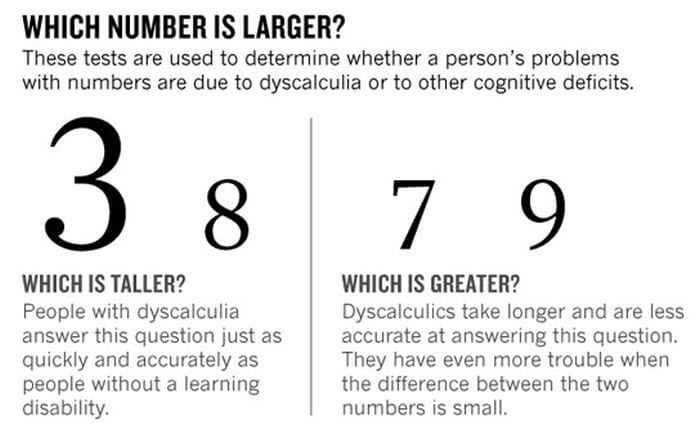
Image Credit: SciTech Daily
So, how can a teacher help? First, as with any learning disorder, make sure your student is evaluated so a proper plan can be put into place. Then, be ready to do some things differently to help them succeed. Many people with dyscalculia can actually do very well at math when given a few accommodations; some even go on to careers in advanced-math fields. Do some research and be ready to experiment with some or all of the following:
- More time: Take the pressure off and let your student work their way to the answer in their own time. This can include allowing more time for tests. Prioritize and praise correct answers over quick ones.
- Less homework: It may seem counterintuitive, but because it takes them longer, dyscalculic students can actually benefit from fewer homework problems. Chances are they can practice the same concepts with five problems instead of 10, with less frustration. Learn more about giving meaningful homework here.
- Moderate memorization: We commonly expect every kid to know their basic-math facts by a certain age, but when it comes to those with dyscalculia, that’s just not reasonable. Rote memorization and flashcards don’t work for them. Explore other methods, like fact fluency, instead.
- Allow aids: When possible, allow students to use a calculator or take an open-book test, especially if the concepts you’re testing don’t rely on those basic-math facts. Focus more on understanding the ideas rather than memorization and recall. (See: Why It’s Important to Honor All Math Strategies)
- Employ many methods: All kids benefit from a variety of teaching and learning methods. Try number lines, math manipulatives, color coding, and interactive games. When a student has difficulty understanding material presented one way, look for other ways to teach the concept. (See: 11 Essential Strategies in Teaching Math)
- Find a tutor: Kids with dyscalculia can benefit from a tutor, but it’s best to find one who understands and has worked with students with learning disorders. Classroom teachers can work with tutors to apply methods that work, both in the classroom and beyond.
Get dyscalculia resources.
The best way to help a student with dyscalculia is to learn more about it. Start with these resources.
Online:
- Dyscalculia.org
- Understanding Dyscalculia, Understood.com
- Math & Dyscalculia, LD Online
Books:
- The Dyscalculia Toolkit: Supporting Learning Difficulties in Maths (Bird, 2017)
- The Dyscalculia Resource Book: Games and Puzzles for ages 7 to 14 (Bird, 2017)
- The Math Handbook for Students with Math Difficulties, Dyscalculia, Dyslexia or ADHD (Faber, 2017)
Have you had a student with dyscalculia? Come share your experience with us in our WeAreTeachers HELPLINE group on Facebook.
